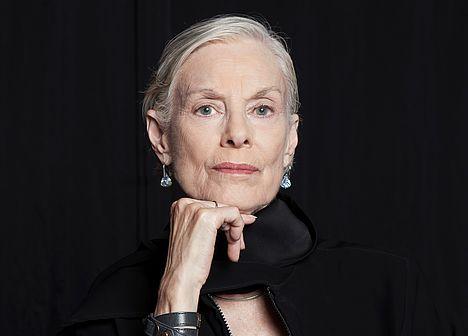
Geometry and minimalism
Lucinda Childs is considered the »Queen of Minimalism«. Since the 1970s, the American has created a groundbreaking oeuvre - first as a member of New York's Judson Dance Theater, that long legendary, boundary-crossing artists' collective, then later with her own company and as a freelance choreographer working for renowned companies worldwide. With Concerto, the Vienna State Ballet presents for the first time a work by this important representative of postmodernism. In conversation with Nastasja Fischer the artist speaks about her work.
There are two paths in the history of your choreographic work. Pieces, which center pure movement and creations, which unite music, picture, video and dance.
Lucinda Childs I made dances in the early seventies with no musical accompaniment that were performed in silence in alternative spaces like churches, galleries, and rooftops. They were not limited to the one-sided view of the traditional proscenium stage. After participating with Robert Wilson and Philip Glass in 1976 as performer and choreographer on the opera Einstein on the Beach I was eager to continue to work again with Philip Glass’ music on a full-length work. In 1979, this became Dance with a film/décor created by Sol LeWitt. The classical stage space no longer seemed confined. I embraced the traditional collaboration between a choreographer, composer, and visual artist because we all shared the same minimalist aesthetic. The work is still performed by my company and is also in the repertory of the Lyon Opera Ballet.
When it comes to your work the word »perception« is most likely used. As you work often with repetitive and geometric patterns it is also a task for the audience to challenge themselves and their perceptual abilities.
LC Yes, perception is an important part of the minimalist aesthetic. Variation is achieved through reintroducing thematic material in different kinds of sequential patterns. I don’t think of the audience while creating, but I’ve been told that I make them think. It’s necessary to engage intellectually with the work to comprehend that the treatment of the content of the work is as important as the content itself. It is not just repetition for the sake of repetition but rather a more subtle adventure into the abstract world of theme and variation.
Where does your interest in repetition, geometry, structure come from?
LC I’m interested in the precise use of space in my dances. I depend on geometric structure to create spatial patterns for the dancers that can be arranged from different points of view.
The Vienna State Ballet will show your work Concerto, which had its world premiere in 1993 in Lisbon. The motifs of repetition and geometrics are there as well, but it is also about ballet technique and movements. What was your inspiration for the piece?
LC There really is no »Lucinda Childs vocabulary«. I use balletic material that I’ve modified and to some extent simplified. What’s original is how the material is used as well as its style. Henryk Górecki’s Harpsichord Concerto is dedicated to the Polish harpsichordist Elisabeth Chojnacka. After listening to it with her, I wanted to use it for my company and she was kind enough to contact Górecki to obtain permission.
What interested you in his music?
LC Quite simply I think that the music is beautiful.
Concerto is also about meetings and partings, where the dancers almost appear in »waves«. Which visual shape did you want to give to the piece?
LC With Concerto, the dance is the music.
You once said that Ballet is the best way to train and to stay in shape for a dancer - no matter where they come from.
LC I find Ballet training essential for dancers, who perform my work. It is the most efficient and effective way that I know of for preparing the dancer.
In Vienna Concerto is shown in a triple bill next to works from George Balanchine and Jerome Robbins. Do you have any kind of an artistic relationship to them?
LC I have always been inspired by the choreography of George Balanchine and Jerome Robbins and was fortunate to grow up as a native New Yorker so close to the home of New York City Ballet.
Can you describe what it means for you to restage a piece with Vienna State Ballet? Do you have a relationship with Vienna?
LC In 1997, I performed with Michel Piccoli in Robert Wilson’s production of Marguerite Duras’ LA Maladie de la Mort in Vienna. I was most recently there with my company in 2010 with performances of Dance at the Tanzquartier. Concerto has been restaged with companies other than my own more than any other work in my repertory. I’m especially pleased to have it on this program with this company.
Your creations demand a lot from the dancers in terms of concentration, stamina, certain use and level of energy. What does a »Childs dancer« need to have?
LC Concentration is of course a major consideration. For me, the dancer’s expression comes from their intense concentration. Also the ability to sustain the energy level. But a strong musical sensibility is of utmost importance.
You document your creations in scores. Can you elaborate your notation system?
LC My scores are a series of overhead maps revealing each of the dancers’ paths in space as well as their relationship to other dancers and to the music.
You are directing Operas as well.
LC Yes, the approach is different. I participated as performer and choreographer in many of the productions of Robert Wilson and Luc Bondy and learned a great deal from them. With dancers, we speak the same language. With singers, it is the libretto that brings us together in a dialogue to find meaning for their movement.